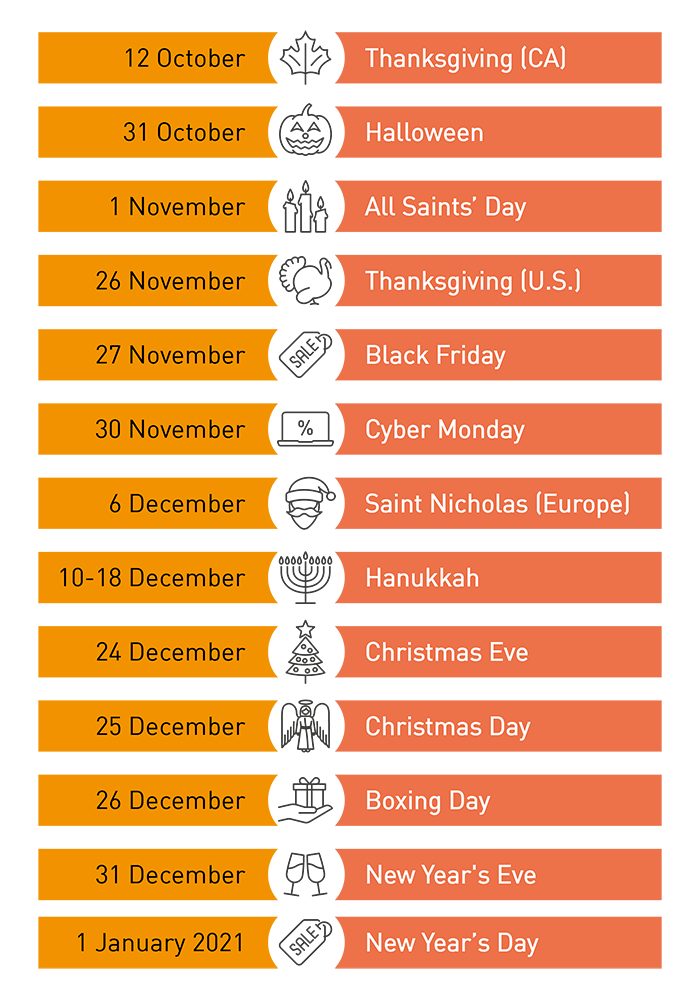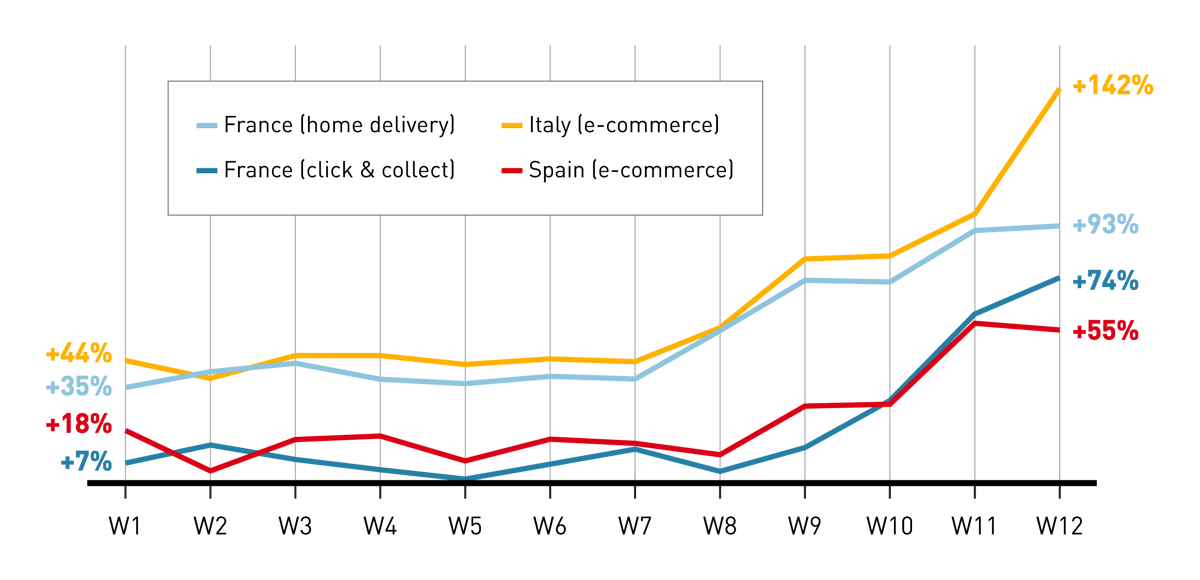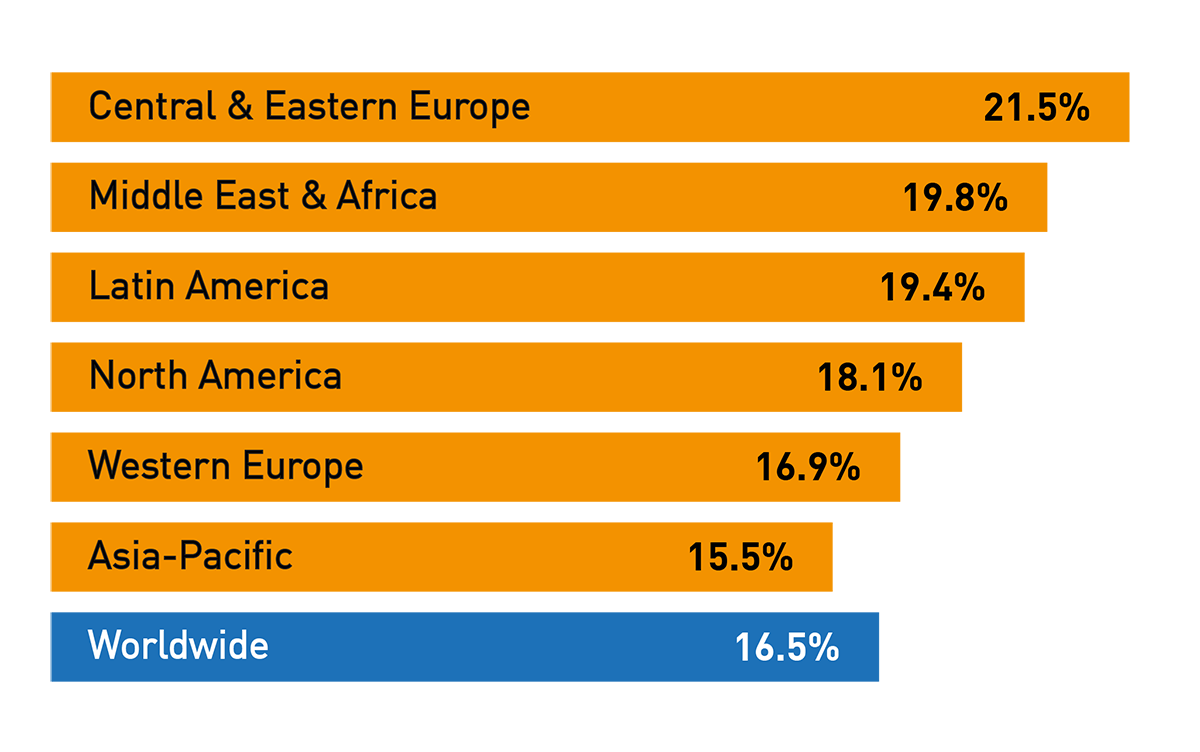
Online holiday sales to set another record this year despite COVID-19
This year’s holiday season will be unique in every respect. However, it is not the extraordinary mood that will make this time unprecedented, but the continuing global pandemic which first put us into lock down in spring, then forced us to change our summer vacation plans. Now, it is going to affect the upcoming holidays and how people prepare for them.
The most wonderful time of the year
The holiday season has always been the peak selling season for the majority of retailers across the globe. And although the shopping spree traditionally begins the day after the American Thanksgiving, which is Black Friday, many brands and businesses start their festive-related activities weeks or even months before, especially when it comes to the online channel.
In practice, numerous online shops are putting out their first Christmas offers already in late September, while the rest usually follow by the end of October. This way, retailers strive to extend the holiday shopping season as much as possible.
According to a recent survey by Radial, as much as 39% of U.S. consumers plan to start shopping for this year’s holidays already in October into early November. And since many U.S. shopping events have spread around the world, lots of Europeans also begin their Christmas purchases much earlier now than they used to a few years ago.

Fig. 1 — Holiday season 2020 calendar
In recent years, it has become the norm that each holiday season brings a remarkable increase in online sales that significantly surpasses the total retail sales growth during that period. According to Salesforce, across the entire 2019 festive season, global digital revenue grew by 8%, totaling $723 billion in sales. However, there are countries where this surge in the online channel was even greater.
The study carried out by the the Centre for Retail Research indicates that France, Germany and the UK belong to such countries where there was a significant increase in online sales during the 2019 holiday season compared to 2018. Unfortunately, this growth was at the expense of brick-and-mortar stores which, on average, recorded a decrease in sales year-over-year (YOY).
The highest holiday e-commerce growth was in Germany and accounted for 12.6%, while offline retail recorded the largest drop of 2.3%. In France, brick-and-mortar retailers did not experience any growth compared to 2018, unlike online ones who showed an increase of 12.5%. In the UK, online sales during the holidays rose by 10.1%, as opposed to physical stores which experienced a decrease of 1.5%.
As a result of the continued rapid increase in e-commerce sales, online retailers’ share of Christmas trade keeps growing. According to the Centre for Retail Research, in 2019, in the UK online accounted for 32.4% of Christmas retail sales, in Germany — 26.1% and in France — 20.3%.
COVID-19 causes record in online sales
There’s every indication that this year’s Christmas has a chance to break all previous e-commerce records on an unprecedented scale. The expected second wave of the pandemic can cause the holiday shopping madness to move from brick-and-mortar stores to the internet. At least to the extent that can generate such a significant increase in sales as we have not seen before during any previous holiday season.
Doubtful? Not really. Just take a look back at what happened to online sales during the first wave of the pandemic when within just a few weeks e-commerce grew several dozen to even several hundred percent in many product categories.

Fig. 2 — FMCG e-commerce sales growth in select West European countries during the coronavirus outbreak
Source: Nielsen. Percentage change vs. corresponding week of prior year.
And even after the lockdown was lifted and stores were reopened, many consumers still preferred to shop online. As a result, according to ACI Worldwide, global e-commerce sales rose 28% in June 2020 compared to June 2019, making it the largest YOY increase in online sales since COVID-19 restrictions were put in place in March. In addition, in June 2020 e-commerce purchase volume increased by 31% compared to June 2019, up from 23% in both April and May.
It looks like e-commerce is one of the few bright spots for merchants amid the COVID-19 pandemic. While this year’s total retail sales worldwide are expected to be down 5.7% from 2019, hitting $23.358 trillion, the global online sales are estimated to grow 16.5% YOY, reaching $3.9 trillion in 2020. And although this is less than the previous estimate, which assumed a growth rate of 18.4%, the increase is evident and still significant.

Fig. 3 — Anticipated 2020 retail e-commerce sales growth worldwide
Source: eMarketer, May 2020.
Note: includes products or services ordered using the internet via any device, regardless of the method of payment or fulfillment; excludes travel and event tickets, payments such as bill pay, taxes or money transfers, food services and drinking place sales, gambling and other vice goods sales.
As for Germany, eMarketer predicts e-commerce sales to rise 16.2% this year, and total $92.33 billion, compared with $79.47 billion in 2019. By contrast, total retail sales are expected to fall 8.2% YOY, from $897.97 billion in 2019 to $824.05 billion in 2020.
Obviously, a large part of this growth worldwide was generated by the boom in online shopping during the lockdown from March to May. But surely the holiday season may still surprise us and bring a second wave of online shopping spree. It all depends on what happens with the pandemic.
One thing is certain. The coronavirus crisis irreversibly changed the shopping habits and behavior of a vast number of consumers across the globe. As a result, people have been buying more online, including items they hadn’t bought on the Internet before. What’s more, e-shops have attracted a huge number of new customers who had never ordered any products online in the past. Many of them are elderly people who have overcome their fears of online shopping and are now ready to continue to do so in the future. This bodes well for e-commerce sales during the holiday season.

I’ll be home for Christmas. Buying online
A scenario of another lockdown is unlikely. It is more realistic for the authorities to impose various types of restrictions, such as limiting the number of people inside the stores. On the other hand, many responsible retailers — especially those with well-developed online channels — will voluntarily introduce such constraints or simply close their stores temporarily in order not to expose consumers to mass infections and to protect the health of their employees.
In fact, this is already happening. More and more U.S. retailers are declaring that they will close their stores on Thanksgiving and Black Friday. Target, Macy’s, Foot Locker, JCPenney, Kohl’s, Bed Bath and Beyond, and Best Buy are among those who have already announced these decisions and are now inviting customers to visit their online stores on Black Friday to shop for best deals.
In Europe, it is more likely that stores will remain open and only the number of people entering will be limited. Whether introduced by the authorities or retailers themselves, such restrictions will inevitably lead to long queues outside the stores, especially during the busiest shopping days of the festive period.
Unfortunately, as winter approaches with rain, wind, frost and snow, customers will be less willing to wait in front of the store for at least several minutes to get in. Such queueing can effectively destroy the Christmas spirit and discourage many consumers from visiting brick-and-mortar retailers.
If at the same time we witness a significant increase in the number of infection cases and deaths, the fear of crowded areas will return. Once again, people will start avoiding public places like shopping malls, stores, restaurants, and pubs. Many will again choose social distancing and self-quarantine to reduce the risk of infection. For this reason, we can be pretty sure that with the second wave of the pandemic, there will be another surge in online sales.
However, the question arises as to whether the negative effects of the pandemic in terms of higher unemployment, lower wages and increased poverty will not drastically reduce this year’s holiday spending in both the online and offline channels.
Surprisingly, it turns out that despite much weaker financial condition, most households do not intend to reduce their Christmas spending this year. According to Rakuten Advertising research, over 70% of consumers worldwide are not planning to decrease their spend for 2020 peak shopping days, despite more than 40% of shoppers citing a decrease in household expenditures due to COVID-19.
Moreover, there is another positive consumer trend even under a return to full lockdown, with 55% of global consumers saying they would not decrease their peak spend during this holiday season. This looks even better when it comes to German consumers. 60% of them declare not to reduce their Christmas expenses even if the full lockdown is imposed again.
Such consumer declarations, together with the significant e-commerce growths in recent months, are encouraging online retailers to be quite optimistic about the fourth quarter of 2020. This positive attitude is reflected in a survey by Bazaarvoice which revealed that 85% of brands and merchants still anticipate higher online sales this holiday season compared to previous ones.
But what exact growth of e-commerce can we expect this Christmas? This is difficult to predict since it all depends on how the situation with the pandemic will develop and how soon the vaccine will be released. However, according to Salesforce predictions, up to 30% of global retail sales will be made through digital channels this upcoming holiday season. If this happens, there is really something to fight for.

